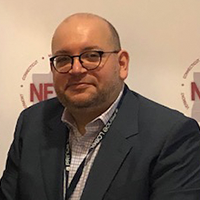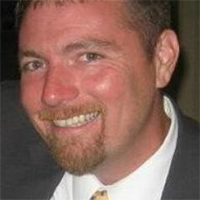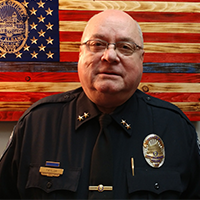 Jill Nicholson is the Senior Director of Customer Education at Chartbeat, a content intelligence platform for publishers. She trains journalists around the world on turning metrics into action. Before that, she was a long-time Chartbeat user — curating a local news site in Westchester, NY. In her four years at Chartbeat, Jill has supplemented her newsroom experiences with best practices learned from the diverse organizations that Chartbeat serves.
Jill Nicholson is the Senior Director of Customer Education at Chartbeat, a content intelligence platform for publishers. She trains journalists around the world on turning metrics into action. Before that, she was a long-time Chartbeat user — curating a local news site in Westchester, NY. In her four years at Chartbeat, Jill has supplemented her newsroom experiences with best practices learned from the diverse organizations that Chartbeat serves.
Jill Nicholson
S. W. (Sammy) Papert, III
 A Dallas, Texas native, Sammy Papert is a graduate of St. Mark’s School of Texas and the “worst” student actually graduating from Stanford University. The registrar will confirm that claim.
A Dallas, Texas native, Sammy Papert is a graduate of St. Mark’s School of Texas and the “worst” student actually graduating from Stanford University. The registrar will confirm that claim.
In his first legitimate venture, Mr. Papert founded, owned and operated The Executive Toy Store, a Sharper Image before its time and Mr. Papert’s “MBA of the streets”. Again, he barely “graduated.”
From 1981 to 1997 he joined the Papert Companies, a newspaper marketing solutions firm and pushed, cajoled, begged and pleaded both advertisers and Publishers to grow the organization to 450 middle and small market newspapers across the country.
In July 1998, Mr. Papert became Chairman and CEO of Belden Associates, the one-time premier newspaper research and consultancy in North America. At least, that’s what he told the competition.
Mr. Papert recognized a golden opportunity so started Wormhole during this country’s greatest recession to do just what the name implies – connect organizations with their business and consuming audiences in unique and fast ways by leveraging new technology. AdSeller and saambaa are his two current clients and both are superb and getting better!
Papert is and has been involved in many civic organizations. These include: the Cystic Fibrosis Foundation, Salesmanship Club, Goodwill Board, Theatre Operating Company, St. Mark’s Alumni Association, Stanford Barely Alumni Association and the Dallas Child Guidance Clinic.
Mr. Papert is finally married; enjoys swimming, tennis, reading, writing and eventually visiting all the Caribbean Islands, along with collecting space art and Hawaiian shirts. Don’t ask how many! His latest hair-brained scheme is to make his own wine…the word is he might have finally gotten something right!
Paul Pronovost
 Paul Pronovost is the Executive Editor of the Cape Cod Media Group, which includes the Cape Cod Times, CapeCodTimes.com, CapeCodOnline.com, PrimeTime Cape Cod, The Cape Codder, Provincetown Banner, The Register, Sandwich Broadsider, Bourne Courier and The Bulletin.
Paul Pronovost is the Executive Editor of the Cape Cod Media Group, which includes the Cape Cod Times, CapeCodTimes.com, CapeCodOnline.com, PrimeTime Cape Cod, The Cape Codder, Provincetown Banner, The Register, Sandwich Broadsider, Bourne Courier and The Bulletin.
Cape Cod Media Group papers have been the NENPA Newspaper of the Year many times and the Cape Cod Times has received other top prizes, including the Thomas K. Brindley Public Service Award, the NENPA First Amendment Award and E&P’s EPPY Award. In 2016, the Times was named GateHouse Media’s Newspaper of the Year and Pronovost was named Editor of the Year.
Before coming to the Cape, Pronovost worked at several weekly and daily newspapers in Greater Boston.
An enthusiastic believer in the future of media, Paul has helped champion several efforts to evolve in the digital age, including work on the Dow Jones Future of Content project and the GateHouse Digital Next project.
Paul holds a BA in English from Saint Anselm College and a MPA from Suffolk University. He has been Pulitzer Prize juror and is past president of the Massachusetts Press Association. Paul also has been involved in ommunity leadership endeavors, including board of director seats on the Cape Cod Times Needy Fund, the Salvation Army, and the Community Leadership Institute of Cape Cod. He has been a volunteer soccer coach and Destination Imagination coach for many years.
Jason Rezaian: Keynote Speaker
 Jason Rezaian served as Tehran bureau chief for the Washington Post and is now an opinion writer for the paper and contributor to CNN. He was taken into custody by Iranian authorities in 2014 and charged with espionage. He was detained at Evin Prison in Tehran served 544 days before his release was negotiated. He lives in Washington, DC, with his wife.
Jason Rezaian served as Tehran bureau chief for the Washington Post and is now an opinion writer for the paper and contributor to CNN. He was taken into custody by Iranian authorities in 2014 and charged with espionage. He was detained at Evin Prison in Tehran served 544 days before his release was negotiated. He lives in Washington, DC, with his wife.
Bob Sacha
 Bob Sacha is a director, cinematographer, editor, teacher, photographer and, above all, a collaborator on visual journalism projects. He has created video for projects that have won the Pulitzer Prize, a National Emmy for New Approaches to News and Documentary Programming, a Webby and the first gold medal ever given by the Society for News Design. He was the director of photography for the New York TImes series, Living City, about New York’s infrastructure. BlindSight, a documentary short about a group of blind photographers that he directed and shot, had its world premiere at DOCNYC, the country’s largest documentary festival.
Bob Sacha is a director, cinematographer, editor, teacher, photographer and, above all, a collaborator on visual journalism projects. He has created video for projects that have won the Pulitzer Prize, a National Emmy for New Approaches to News and Documentary Programming, a Webby and the first gold medal ever given by the Society for News Design. He was the director of photography for the New York TImes series, Living City, about New York’s infrastructure. BlindSight, a documentary short about a group of blind photographers that he directed and shot, had its world premiere at DOCNYC, the country’s largest documentary festival.
He was recently named an Associate Professor for Video Storytelling at the Craig Newmark Graduate School of Journalism at the City University of New York, where for four years straight he received the Tow Foundation Grant for “teachers who have demonstrated exceptional leadership in their fields.” Known for his innovative approach to visual storytelling and his engaging teaching style, he received one of the initial Journalism360 Grants for Immersive Storytelling to bring 360 video journalism to community media organizations in the NYC area.
He has lectured and taught workshops and classes at Columbia University Graduate School of Journalism, SVA, the International Center of Photography’s New Media Narratives, CAMERA, the Italian Center for Photography and around the world for National Geographic Expeditions.
In the hazy past, he had a long career as a photojournalist, first for The Philadelphia Inquirer, magazines like LIFE and National Geographic, then he worked as an editor/producer at the multi-award winning MediaStorm. He is currently interested in looking deeper into 360 video and spatial audio and using his iPhone to capture the world around him every day.
Tim Schmitt
 Tim has spent decades in various newsrooms — some print, and some broadcast. He was a sports reporter, news reporter, and then managing editor of his hometown paper, the Tonawanda (N.Y.) News, where he led an award-winning editorial page. He’s worked as an editor, staffer or longtime contributor with the Arizona Daily Sun in Flagstaff, the Mesa Tribune, the Arizona Republic, the alt-weekly Buffalo Current, and the Niagara Falls Gazette, where he was executive sports editor over four dailies — spearheading coverage of the Buffalo Bills and Sabres. He also worked as a weekend anchor and reporter at Buffalo’s ABC-TV affiliate, WKBW, and was the news director of WLVL-AM in the Buffalo market, where he hosted a daily two-hour talk show covering local politics and current events. He moved to Austin to join GateHouse in early 2015.
Tim has spent decades in various newsrooms — some print, and some broadcast. He was a sports reporter, news reporter, and then managing editor of his hometown paper, the Tonawanda (N.Y.) News, where he led an award-winning editorial page. He’s worked as an editor, staffer or longtime contributor with the Arizona Daily Sun in Flagstaff, the Mesa Tribune, the Arizona Republic, the alt-weekly Buffalo Current, and the Niagara Falls Gazette, where he was executive sports editor over four dailies — spearheading coverage of the Buffalo Bills and Sabres. He also worked as a weekend anchor and reporter at Buffalo’s ABC-TV affiliate, WKBW, and was the news director of WLVL-AM in the Buffalo market, where he hosted a daily two-hour talk show covering local politics and current events. He moved to Austin to join GateHouse in early 2015.
Eugene Sonn
 For nine years Eugene Sonn was the familiar voice covering New Jersey politics and the state house in Trenton for WHYY, in partnership with WBGO FM in Newark, N.J.
For nine years Eugene Sonn was the familiar voice covering New Jersey politics and the state house in Trenton for WHYY, in partnership with WBGO FM in Newark, N.J.
While on that beat, Gene won several awards, including from PRNDI (Public Radio News Directors Inc.) for covering former Gov. Jim McGreevey’s resignation speech in 2004. Other notable stories he covered then included the anthrax attacks on the postal system after 9/11, the 2006 state government shutdown, James Dale v. Boy Scouts of America (challenging ban on openly gay scout leaders, which went to U.S. Supreme Court), and racial profiling by the New Jersey State Police. While following wildlife biologists in 2003, Eugene Sonn “interviewed” a black bear in northwestern New Jersey. The bear had been captured in a leg hold trap and tranquilized before the biologists examined it and took specimens to help track the rebounding bear population. For the record, the bear did not like the idea that New Jersey was going to allow hunting for the first time in three decades.
After spending more than two years taking care of his first son and doing freelance reporting for various local and national outlets, he returned to WHYY in April, 2010 as Audio News Director. Under his direction, WHYY has won the Pennsylvania Associated Press Broadcasters Association Joe Snyder Award for Outstanding News Service several times. He lead the team through coverage of the Amtrak train #188 crash in Philadelphia, Pope Francis’ visit, the 2016 Democratic National Convention among other big stories.
Gene first came to our region to attend Swarthmore College. He spent three years working for public radio station WRVO in Oswego, N.Y. before leaving behind that town’s annual epic snowfalls. These days Gene lives in Bucks County and daydreams of spending more time biking on the quieter roads there. However, he and his wife Jess are busy raising two young sons. Having grown up in Carlisle, Mass., he’s still a rabid fan of the Boston Red Sox.
Trent Spiner
 Executive Editor Trent Spiner, 32, of Concord, leads an experienced news team focused on comprehensive coverage of New Hampshire, including aggressively reporting local and state political news, as well as New Hampshire’s high profile first-in-the-nation Presidential primaries. After being named to the post in 2015, Spiner has focused on boosting the Union Leader’s digital presence and social media strategies. Previously, he was a reporter for the Concord Monitor and Union Leader. He was a news assignment editor at WMUR-TV, where he was also a manager of the Hearst station’s website and social media output.
Executive Editor Trent Spiner, 32, of Concord, leads an experienced news team focused on comprehensive coverage of New Hampshire, including aggressively reporting local and state political news, as well as New Hampshire’s high profile first-in-the-nation Presidential primaries. After being named to the post in 2015, Spiner has focused on boosting the Union Leader’s digital presence and social media strategies. Previously, he was a reporter for the Concord Monitor and Union Leader. He was a news assignment editor at WMUR-TV, where he was also a manager of the Hearst station’s website and social media output.
Chief Gary Taylor
 Chief Gary Taylor has more than 41 years of full time law enforcement experience. He also is the Public Safety Director for St. Albans, where he serves as Fire Chief and Emergency Management Director 20 years of experience in both disciplines. Taylor has extensive training by the FBI National Academy and the International Association of Chiefs of Police.
Chief Gary Taylor has more than 41 years of full time law enforcement experience. He also is the Public Safety Director for St. Albans, where he serves as Fire Chief and Emergency Management Director 20 years of experience in both disciplines. Taylor has extensive training by the FBI National Academy and the International Association of Chiefs of Police.
Sonya Vartabedian
 Sonya Vartabedian is managing editor of features, magazines and special projects for North of Boston Media Group based in North Andover, Mass. She was part of the team that helped launch NOBMG’s magazine division in 2008 and now oversees production of the media group’s 12 quarterly lifestyle magazines as well as it quarterly business magazine. In addition, she manages the production of the special sections as well as the features sections for NOBMG’s four daily and four weekly papers, including The Eagle-Tribune. Sonya began her 30-year career in community journalism in 1988 as a reporter with her hometown paper, the then-daily Haverhill Gazette. In 1990, she joined The Daily News of Newburyport, where she spent more than 20 years as a reporter, features and magazine editor, and finally city editor. She then served for two years as editor of North of Boston Media Group’s Andover Townsman weekly newspaper before relocating to NOBMG’s main hub at The Eagle-Tribune in 2015.
Sonya Vartabedian is managing editor of features, magazines and special projects for North of Boston Media Group based in North Andover, Mass. She was part of the team that helped launch NOBMG’s magazine division in 2008 and now oversees production of the media group’s 12 quarterly lifestyle magazines as well as it quarterly business magazine. In addition, she manages the production of the special sections as well as the features sections for NOBMG’s four daily and four weekly papers, including The Eagle-Tribune. Sonya began her 30-year career in community journalism in 1988 as a reporter with her hometown paper, the then-daily Haverhill Gazette. In 1990, she joined The Daily News of Newburyport, where she spent more than 20 years as a reporter, features and magazine editor, and finally city editor. She then served for two years as editor of North of Boston Media Group’s Andover Townsman weekly newspaper before relocating to NOBMG’s main hub at The Eagle-Tribune in 2015.
